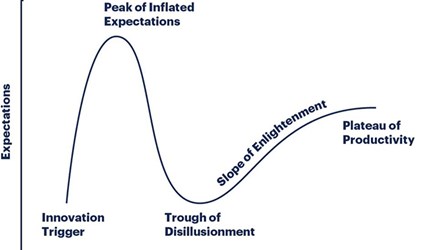Digital Transformation Requires Business Model Innovation
Digitalization and the use of new technologies can be a powerful force of disruption in many (traditional) industries as new companies enter with faster and better business models. The journey to digital transformation requires the comprehensive reimagining and reinvention of incumbents’ business models.
Only a decade ago, “going digital” meant data mining, search technology, and virtual collaboration. The business model of the company remained intact, while managers “added” on new digital practices.
Today, managers are focusing their energy toward artificial intelligence, machine learning, and the Internet of Things. As humans, we are naturally attracted to new and shiny things. And there is no doubt that combining different technologies such as cloud technologies, sensors, big data and 3D printing opens unforeseen possibilities and offers the potential to create new products and services.

However, as the Gartner Hype Cycle illustrates, we often end up in the through of disillusionment. Many technologies are abandoned as it remains unclear how the technology can benefit the enterprise or how it can address a substantial customer need.
It is only after the technology has been embedded into a solid business model, that its value-creating potential becomes apparent.
For example, the adoption of solar panels had been historically slow since 1970s, although the price of photovoltaic cells had been decreasing. It was only in 2008 that some companies started to offer leasing and managing the rooftop solar. It was this new business model that gave solar power the edge over grid energy.
 In fact, “digital growth depends more on business models than it does on technology”[1]. While technology is an important “enabler”, it is the way that the company uses this technology to satisfy real customers who need real jobs to be done – that is, addressing a fundamental problem in a given situation that needs a solution. The problem is that we often start the innovation process from where we are today. Instead, we need to create business models with the customer of the future in mind.
In fact, “digital growth depends more on business models than it does on technology”[1]. While technology is an important “enabler”, it is the way that the company uses this technology to satisfy real customers who need real jobs to be done – that is, addressing a fundamental problem in a given situation that needs a solution. The problem is that we often start the innovation process from where we are today. Instead, we need to create business models with the customer of the future in mind.
Here are the key elements of a future-oriented, digital business model:
- Identify your specific target audience. Long gone are the times when companies could push a product or service to a mass market. Technology provides the opportunity to personalize production to the unique wants of the individual. Customers want to be appreciated for their uniqueness. Think of how Amazon uses Big Data to serve a “micro-segment” of antique-book lovers. In the future, an increased emphasis on co-creation allows for customized consumption.
- A strong value proposition: What is the “job-to-be-done”? We are heading towards a world of constant connectivity and where access is prioritized over ownership. This has fundamental implications for traditional value propositions. Future customers expect on-demand everything. Recall how Netflix, by relying on the cloud, is able to provide instant, on-demand video streaming. This affects other areas of life as well, where customers increasingly value convenience, immediacy and flexibility.
- Value delivery: The value delivery component of a business model entails all activities required to produce the value proposition (e.g. from receiving input materials to manufacturing and delivery of the finished product to the customer). Here, new digital technologies can vastly improve process efficiency, use of resources, work procedures, etc. However, more importantly, new technologies can be employed to give customers the power to unbundle, customize, and mix elements of the value offering.
- Value capture: We are shifting away from the traditional transactional model of charging for the one-time purchase of a product or service. Subscription models, such as the Dollar Shave Club, disrupt through “lock-in” by taking a product or service that is traditionally purchased on an ad hoc basis (razors and shaving cream) and charging a subscription fee for continued access to the product/service. Others, such as platform providers, capture value by connecting demand and supply in the most convenient and targeted way.
In other words, new digital technologies hold much promise for creating, delivering and capturing value in radically new ways – as long as they are embedded in a smartly designed business model. As Henry Chesbrough famously said “the same idea or technology taken to market through two different business models will yield two different economic outcomes”.[2]
More News and Blogs from The hub@nhh
[1] Johnson, M. (2018). Digital growth depends more on business models than it does on technology. Harvard Business Review. https://hbr.org/2018/12/digital-growth-depends-more-on-business-models-than-technology
[2] Chesbrough, H. (2010). Business Model Innovation: Opportunities and Barriers. Long Range Planning, 354-363
